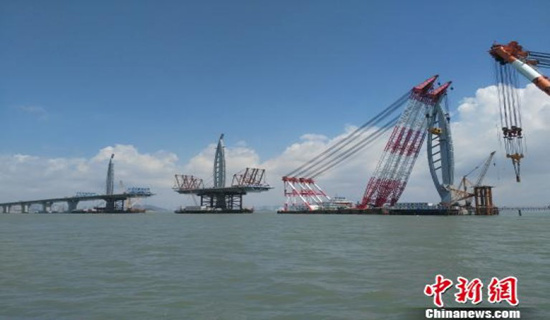By Tom McGregor, CCTV.com Panview commentator and editor
China is a leading nation in building massive infrastructure projects both at home and abroad. Projects, including constructing roads, railways and bridges, are expected to transform China and other countries, especially member states signed up with the Belt & Road Initiative.
Chinese builders have set a record-setting pace to build the fastest trains, most powerful satellites and largest power plants. The infrastructure projects when completed can ease transportation congestion, increase cross-border trade and investments and provide plenty of energy for households and businesses.
One major project that will be opened to the public later this year - 2017 - will be the Hong Kong-Zhuhai-Macao Bridge.
World‘s longest over-the-sea bridge
The Y-shaped bridge runs from Zhuhai, Southern China's Guangdong Province and connects to Macao Special Administrative Region (SAR) and western-district of Hong Kong SAR.

An illustration picture of the Hong Kong-Zhuhai-Macao Bridge. (Photo: China News Service)
The total length is measured at 55-km, with a main part including over-the-sea bridge at 22.9-km and the world's longest underwater tunnel at 6.7-km.
Total cost for construction is estimated at around US$10.6 billion. China's Central Government, Hong Kong SAR (HKSAR) and Macao SAR will fund 42 percent of the project and Bank of China had issued a loan for the rest of the financing.
On the mainland side, the key players are the Highway Planning & Design Institute (HPDI), China Communications Construction Co., China Railways Shanhaiguan Bridge Group, Wuchang Shipyard Heavy Engineering, CCCC First Harbor Engineering Co., Guangdong Provincial Changda Highway Engineering and China Zhongtie Major Bridge Engineering Group.
Taking on typhoons and earthquakes
The HK-Zhuhai-Macao Bridge has been designed to withstand typhoons of the force 16, as well as powerful earthquakes up to magnitude 8, according to CGTN. The planned lifespan is for 120 years, instead of the routine 100 years for bridges.
Construction started in 2009. Chinese architects had drawn up a detailed design plan. Manual laborers had been working round-the-clock and Chinese engineers were utilizing state-of-the-art hi-tech innovations to build a bridge that would surpass all others.
"We selected advice of experts from various fields including environmental protection, navigation, hydrology, aviation, social economy, bridge engineering, engineering technologies and weather," the bridge's chief designer Meng Fanchao, told the Global Times.
Before building, designers and engineers were told the bridge cannot interfere in regional shipping and flight routes. The bridge must abide by stringent environmental protection regulations. And of course, public safety remains first priority.
Charging stations for electric vehicles
We can anticipate the HK-Zhuhai-Macao Bridge to support sustainable development and eco-friendly policies. Two artificial islands have already been constructed.
Representatives from the Guangdong Branch of the China Southern Power Grid announced plans to install electric vehicle (EV) charging stations on the artificial islands by the end of 2017.
China.org.cn reports that China Southern Power Grid had invested over RMB90 million (US$13 million.) to install 550 charging stations to help facilitate green development.
The stations can be used to charge different types of EV, including public buses, long-distance coaches, travel buses, shuttle buses and electric taxis.
The charging stations are composed of: 429-DC (direct current) and 121-AC (alternate current). Officials are encouraging more eco-friendly vehicles to use the bridge.
The strategy could be effective, since electric-powered buses can transport a large number of passengers, while gas-powered cars cause carbon emissions and are more likely to create huge traffic jams.
Constructing the tunnel
On July 7, the final section of the underwater tunnel was completed, which runs on the Lingdingyang side of Pealr River Estuary. It's the longest and deepest underwater tunnel in the world - 46-m. below sea-level.
According to AsiaOne, the tunnel has 33-piped sections that are linked by one, 6,500-metric-ton butt joint in the middle. Each pipe weighs 75,000 tons, which is just as heavy as an aircraft carrier.
Construction of the above water section of the bridge was completed last year.
Zhu Yongling, director of the management bureau of the bridge, attended a ceremony to celebrate completion of the main structure of the bridge.
He delivered a speech saying the bridge can boost development of the Greater Guangdong-HK-Macao Bay area.
"The completion of the bridge will significantly change the regional transportation structure on the western bank of the Pearl River," AsiaOne, quotes Chen Guanghan, chief expert at the Institute of Guangdong, Hong Kong and Macao Development Studies at Sun Yat-sen University, as saying.
Intelligent bridge for smart future
The world's longest bridge at sea needs smart solutions to handle traffic accidents and faulty cracks on the bridge. The sooner a problem gets detected, the quicker an emergency response team can resolve them.
Chinese officials plan to install devices on the bridge that can alert traffic control and bridge maintenance workers when something goes wrong.
Engineers will install hi-tech upgrades to ensure smooth traffic flows such as hooking it up to an Intelligent Transportation System (ITS).
Accordingly, operations on the bridge can run more smoothly, setting another example that China continues to introduce amazing innovations for better bridges and a stronger society.
(The opinions expressed here do not necessarily reflect the opinions of Panview or CCTV.com)

Panview offers a new window of understanding the world as well as China through the views, opinions, and analysis of experts. We also welcome outside submissions, so feel free to send in your own editorials to "globalopinion@vip.cntv.cn" for consideration.
















